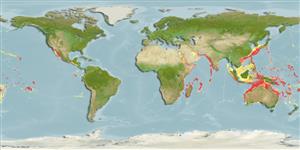Common names from other countries
Environment: milieu / climate zone / depth range / distribution range
Sinh thái học
; Thuộc về nước lợ; Mức độ sâu 1 - 701 m (Ref. 96667). Tropical
Indo-Pacific: from Red Sea to Japan and Hawaii.
Length at first maturity / Bộ gần gũi / Khối lượng (Trọng lượng) / Age
Maturity: Lm ? range ? - ? cm Max length : 6.7 cm TL (female)
Found on muddy sand with sponges, red mud, coarse muddy shell sand to sand with fragments of coralline algae (Ref. 80410). Species can be found in estuarine or brackish waters, from intertidal to subtidal areas (Ref. 106854).
Life cycle and mating behavior
Chín muồi sinh dục | Sự tái sinh sản | Đẻ trứng | Các trứng | Sự sinh sản | Ấu trùng
Some members of the order Stomatopoda pair for life and some come together only to mate. Males produce sperm ducts rather than spermatophores; females can brood a maximum of 50,000 eggs. Life cycle: Eggs hatch to a planktonic zoea which lasts for 3 months.
Ahyong, S.T. 2001. (Ref. 3099)
IUCN Red List Status (Ref. 130435)
CITES status (Ref. 108899)
Not Evaluated
Not Evaluated
Threat to humans
Harmless
Human uses
| FishSource |
Các công cụ
Thêm thông tin
Age/SizeSự sinh trưởngLength-weightLength-lengthHình thái họcẤu trùngSự phong phú
Các nguồn internet
Estimates based on models
Preferred temperature
(Ref.
115969): 11.7 - 26.5, mean 18.6 (based on 573 cells).
